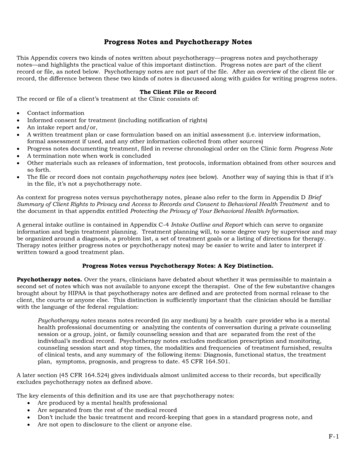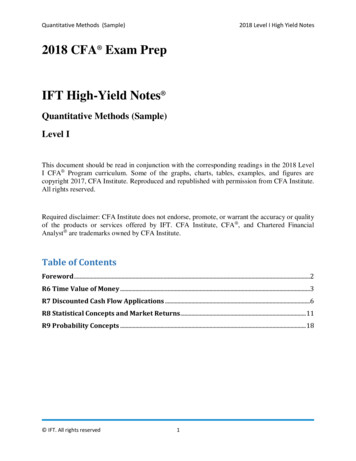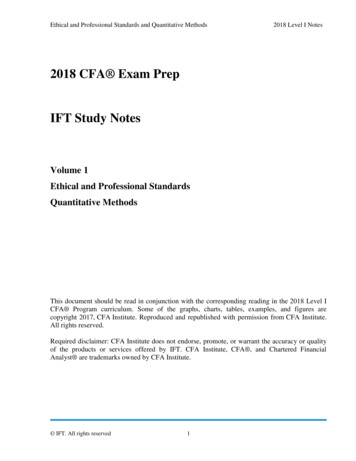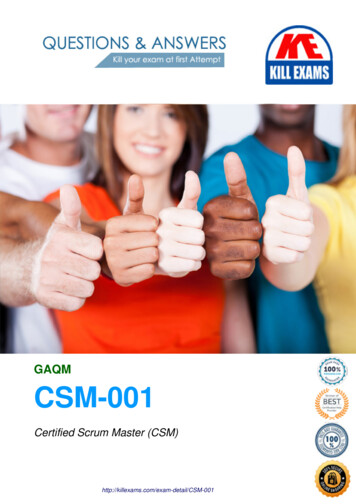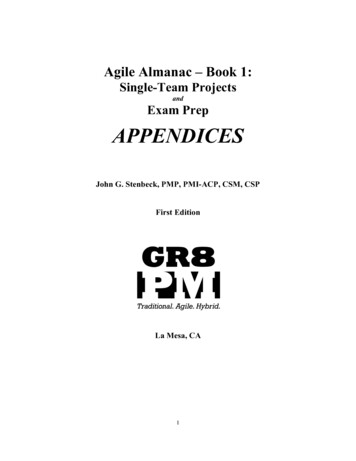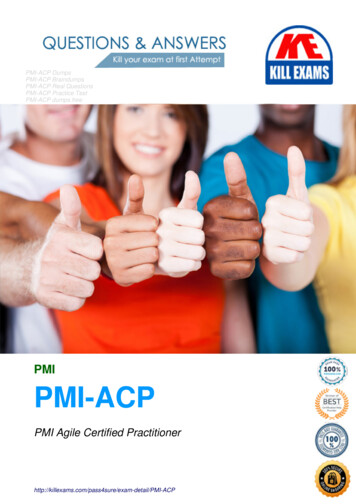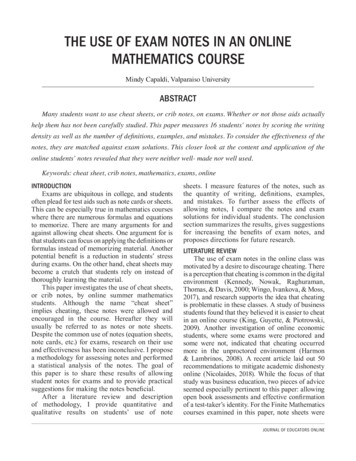
Transcription
THE USE OF EXAM NOTES IN AN ONLINEMATHEMATICS COURSEMindy Capaldi, Valparaiso UniversityABSTRACTMany students want to use cheat sheets, or crib notes, on exams. Whether or not those aids actuallyhelp them has not been carefully studied. This paper measures 16 students’ notes by scoring the writingdensity as well as the number of definitions, examples, and mistakes. To consider the effectiveness of thenotes, they are matched against exam solutions. This closer look at the content and application of theonline students’ notes revealed that they were neither well- made nor well used.Keywords: cheat sheet, crib notes, mathematics, exams, onlineINTRODUCTIONExams are ubiquitous in college, and studentsoften plead for test aids such as note cards or sheets.This can be especially true in mathematics courseswhere there are numerous formulas and equationsto memorize. There are many arguments for andagainst allowing cheat sheets. One argument for isthat students can focus on applying the definitions orformulas instead of memorizing material. Anotherpotential benefit is a reduction in students’ stressduring exams. On the other hand, cheat sheets maybecome a crutch that students rely on instead ofthoroughly learning the material.This paper investigates the use of cheat sheets,or crib notes, by online summer mathematicsstudents. Although the name “cheat sheet”implies cheating, these notes were allowed andencouraged in the course. Hereafter they willusually be referred to as notes or note sheets.Despite the common use of notes (equation sheets,note cards, etc.) for exams, research on their useand effectiveness has been inconclusive. I proposea methodology for assessing notes and performeda statistical analysis of the notes. The goal ofthis paper is to share these results of allowingstudent notes for exams and to provide practicalsuggestions for making the notes beneficial.After a literature review and descriptionof methodology, I provide quantitative andqualitative results on students’ use of notesheets. I measure features of the notes, such asthe quantity of writing, definitions, examples,and mistakes. To further assess the effects ofallowing notes, I compare the notes and examsolutions for individual students. The conclusionsection summarizes the results, gives suggestionsfor increasing the benefits of exam notes, andproposes directions for future research.LITERATURE REVIEWThe use of exam notes in the online class wasmotivated by a desire to discourage cheating. Thereis a perception that cheating is common in the digitalenvironment (Kennedy, Nowak, Raghuraman,Thomas, & Davis, 2000; Wingo, Ivankova, & Moss,2017), and research supports the idea that cheatingis problematic in these classes. A study of businessstudents found that they believed it is easier to cheatin an online course (King, Guyette, & Piotrowski,2009). Another investigation of online economicstudents, where some exams were proctored andsome were not, indicated that cheating occurredmore in the unproctored environment (Harmon& Lambrinos, 2008). A recent article laid out 50recommendations to mitigate academic dishonestyonline (Nicolaides, 2018). While the focus of thatstudy was business education, two pieces of adviceseemed especially pertinent to this paper: allowingopen book assessments and effective confirmationof a test-taker’s identity. For the Finite Mathematicscourses examined in this paper, note sheets wereJOURNAL OF EDUCATORS ONLINE
allowed and proctoring was required. There areavenues to discover plagiarism or other cheatingin many writing-based online courses (Heberling,2002), but mathematics courses do not have as muchready advice for avoiding or catching cheating onlineother than having exams be proctored. Therefore,it is prudent for the instructor to create assessmentpractices that minimize academic dishonesty.While one reason to use exam notes is to decreaseacademic dishonesty, there is also a hope that thenotes benefit student learning. Unfortunately, aliterature survey found no consensus on whetherthe use of notes helps exam performance or studentlearning (Hamouda & Shaffer, 2016). I can seeexamples of the contradictions of previous resultsin the following studies.A few researchers found evidence that cribnotes do not affect exam scores (Hindman, 1980;Trigwell, 1987). Hindman (1980) even noted thatthe number of undergraduate students using notesdeclined as the semester progressed. Both studiesagree that the merit of exam notes is in their creation,i.e., putting thought into what to include in a briefamount of notes necessitates learning the material.On the other hand, Wachsman (2002) reportedthat both preparing and using notes improved thetest performance of economic students. Visco,Swaminathan, Zagumny, and Anthony (2007)examined how ten chemical engineering studentsprepared their exam notes and concluded that“good” notes do not indicate superior examperformance. More specifically, including a largeamount of information on notes did not lead tobetter exam work. Recently, Hamouda & Shaffer(2016) found, in a data structures course, that ifstudents’ exam notes contained information relatedto higher-level questions, then they performedbetter on those questions.Some research has shown that students reliedon their notes instead of truly absorbing thematerial, but that having access to notes or a bookdecreases test anxiety. A “dependency hypothesis”was first proposed by Dorsel and Cundiff (1979),who found in an experimental study that takingaway crib sheets from people who expected to usethem caused significantly lower performance incomparison to participants who never planned to usethe aid. Dickson and Bauer (2008) observed that byunexpectedly giving psychology students a pretestwithout notes and posttest with notes, crib sheetsJOURNAL OF EDUCATORS ONLINEenhanced performance but not necessarily learning.Although these studies indicate the ineffectivenessof constructing crib sheets, most students believethat they are helpful and relieve stress (Dickson &Bauer, 2008). Another study of psychology studentsinvestigated the differences between open-book,cheat sheet, or closed-book exams and had a followup retention quiz and preference survey (Gharib,Phillips, & Mathew, 2012). The results indicatedthat students did slightly better if they had theadditional resources and that they preferred openbook and cheat sheets to closed book. They had theleast anxiety if they were allowed an open book,even compared to cheat sheets. Allowing an openbook exam for online classes could be problematic,though, since the course likely has an e-book, whichleads to the use of electronic devices during exams.De Raadt (2012) countered the Dickson & Bauerpaper by pointing out that cheat sheets are intendedto reduce the need for memorization. Therefore,removing the aid goes against that intended use.Instead of taking away their notes, de Raadt(2012) focused on whether using notes enhancedstudents’ performance compared to their previousassessments. He also compared the work of studentswho used notes and others who did not. Unlike mostprevious studies, de Raadt analyzed the featurespresent on student-created notes and whether thosefeatures related to their exam solutions.Looking at the content of student note sheets,as opposed to just whether or not notes wereallowed for an exam, is a relatively recent avenueof research (Ludorf & Clark, 2014). Visco et al.(2007) explored, through interviews, how tenengineering students made and used their notesheets. Ludorf & Clark (2014) ranked the overallquality, information, density, organization, andcolor use of notes on various scales. The twoauthors chose their rankings and then averagedthem, but interrater reliability was not always high,such as .521 for organization (Ludorf & Clark,2014, p. 62). Results from that research showedthat higher quality and lower density notes wereboth associated with higher test performance,although almost all other factors were not related toperformance. Hamouda & Shaffer (2016) measuredstudent notes based on criteria such as organization,definitions, print versus written, examples, andcolor. They then looked for significant associationswith students’ final exam scores but did not find
any when compared to the overall score. Therewere some significant results when they lookedat specific test questions. Finally, Song, Guo, andThuente (2016) considered variables similar to theother papers, such as density, organization, andnumber of sample answers, formulas, and graphs.They examined the note sheets of undergraduateand graduate engineering students and based onsubjective rankings and adjustments used 1–3 or0–1 scales for the variables. For example, studentswho had “too many” graphs received the poorestscore, 0, for that variable, since the raters felt thatit would not help them. The interrater reliabilityscores, based on Cohen’s kappa, ranged from .69 to.91. That study concluded that note sheets are moreuseful for undergraduate students than graduatestudents and that the notes were perceived bystudents as helpful learning tools and exam aids.The methods described above relate to thosein this paper; I measure density and number ofexamples/definitions. However, I use new strategieswith the goal of less subjectivity and moregeneralization to various disciplines. I also addvariables of interest and extend the investigation tomake connections to the content of exam solutionsand not just exam scores.METHODContext of the StudyThis study uses the final exams from onlineFinite Mathematics classes, all taught by the author,at a comprehensive, primarily undergraduatemidwestern university with approximately 4,500students. This particular course covers systemsof equations, the simplex method, probability,Markov chains, and game theory. It fulfils thequantitative analysis general education requirementand is mandatory for business majors. Studentsin the course range from freshman to seniors. Formost students, it is their last required mathematicsclass. While this class is taught in person duringthe academic year, those students are not allowedto use note sheets for exams. Here I investigate thefinal exams and notes of 16 summer students in theonline version of the course.For the first and second tests of the summer,students could create and use one page of notesfor each test. Two pages (front and back of onesheet) were allowed for the final exam. This notesheet policy was established to discourage actualcheating, which is a common concern in onlinecourses (see Literature Review). A calculator wasalso allowed. To further discourage cheating, allexams were proctored either by the instructor or anapproved third party.Note Sheet MeasurementsThis introductory study proposes a new methodof analysis of student note sheets that can be easilyapplied to many disciplines, is objective, and goesbeyond looking at just exam scores. I also looked atexam solutions. The content and amount of noteswere measured for summer students from the twomost recent iterations of the online course. This morein-depth look at the students’ notes was restrictedto those recent terms because one aspect of theonline course changed, which was a requirement toparticipate in a discussion board. While it does notseem likely that this change substantially influencedthe content of the notes, there is a chance that itdid. In the last two summers, there were 16 studentswho made notes and three who did not.Few schemata for evaluating note sheets werefound in a literature search, and of those found, mostwere for computer science or engineering courses(de Raadt, 2012; Hamouda & Shaffer, 2016; Ludorf& Clark, 2014; Nye, Crooks, Powley, & Tripp,1984). Nye et al. (1984) studied student lecturenotes, measuring the quantity of notes through aword count. On the other hand, de Raadt (2012)gauged the quantity by density, or how much vacantspace was found on the sheet. Similarly, Hamouda& Shaffer (2016) and Ludorf & Clark (2014) gavepercentages of nonblank space to measure quantity,but it was unclear how those percentages weredetermined. Song et al. (2016) used a 1–3 scale torate density.Using a word count is tricky for mathematicsnotes. Instead of English words, the notes oftencontain equations and expressions. For example,would numbers and variables count as “words”?Would each entry of a matrix be a word, or shouldthe entire matrix count as one word? Insteadof measuring the quantity of the notes throughcounting words or estimating a percentage of blankspace, this study uses an image analyzing softwareto calculate the percentage of handwriting on thepage. The MIPAR software (http://www.mipar.us/)employs a “recipe,” which was created specificallyfor this research to address the question of findingthe percentage of handwriting on a page. While thisJOURNAL OF EDUCATORS ONLINE
method does not disassociate handwriting size fromthe quantity of notes, size is also a problem whenconsidering word count or blank space. Measuringthe notes’ density is only used as a broad overviewof quantity and it works well for that purpose. SeeFigure 1 for a comparison of low and high densities.The author’s personal judgement also deems thesetwo note examples as the lowest and highestquantities out of the sixteen examined.Figure 1. Density.The notes on the left had the highest density at14.5. The notes on the right had the lowest densityat 2.9. Only the first page of each student’s notesis shown.Two other features de Raadt (2012) looked atwere code examples (it was a programming course)and answers written in students’ notes. Hamouda &Shaffer (2016) also measured definitions and codeexamples as a fraction of the overall note content.Along these lines, the current study counted thenumber of mathematical examples and definitions.Of interest was which type of information studentsbelieved would be more useful: specific examplesor generalities, such as definitions and formulas.A final category of interest arose when it beca
online students’ notes revealed that they were neither well- made nor well used. Keywords: cheat sheet, crib notes, mathematics, exams, online INTRODUCTION Exams are ubiquitous in college, and students often plead for test aids such as note cards or sheets. This can be especially true in mathematics courses where there are numerous formulas and equations to memorize. There are many arguments .


